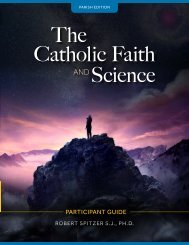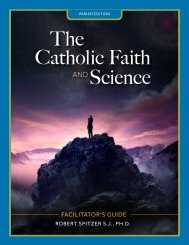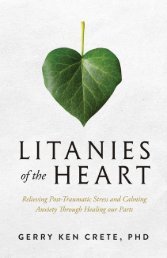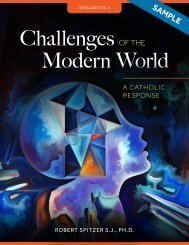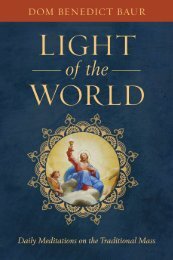Exploring Catholic Social Teaching
You also want an ePaper? Increase the reach of your titles
YUMPU automatically turns print PDFs into web optimized ePapers that Google loves.
Lesson Plan<br />
Materials<br />
ӹ<br />
ӹ<br />
Handout A: Hunter’s Story — “Coming Home”<br />
Handout B: The Corporal and Spiritual Works of Mercy<br />
DAY ONE<br />
Warm-Up<br />
A. Explain that from what something is, we can tell what we ought to do. For example, say: “A man<br />
is hungry. We ought to feed him,” or “A child is being bullied. We ought to stand up for him.”<br />
B. Call on a student to offer an original “is” statement, and then call on the next student to say the<br />
corresponding “ought” statement. Go around the room, alternating between “is” and “ought.” If<br />
students struggle to come up with original statements, you could offer:<br />
ӹ<br />
ӹ<br />
ӹ<br />
ӹ<br />
ӹ<br />
ӹ<br />
A man is drowning, and you have a life preserver./You ought to throw it to him.<br />
A new student at your school is lonely./You ought to welcome him.<br />
A friend is struggling in math, and you are good at math./You ought to help him.<br />
A man is dying of thirst./You ought to give him water.<br />
An elderly person is walking onto a crowded bus./You ought to give that person your seat.<br />
A friend is sick in the hospital./You ought to visit and cheer up your friend.<br />
C. When it becomes your turn, make the statement: “You are created in God’s image and likeness.”<br />
D. The class’s response should be something to the effect of, “We ought to live as the Lord lives.”<br />
E. Ask students to volunteer some things they know about how Jesus lived. Accept reasoned<br />
answers that evidence Jesus’ self-giving love and sacrifice on the Cross for our salvation. Lead<br />
students to the conclusion that in addition to suffering death, Jesus gave us many concrete<br />
examples of how to show love to one another. We will study those in this unit and learn about<br />
how we can live them ourselves.<br />
Activity<br />
Distribute copies of Handout A: Hunter’s Story — “Coming Home” to each student and have them<br />
read the story and answer the questions.<br />
Formative Assessment<br />
A. Have a student summarize the story.<br />
B. Invite students to share their responses to questions 2 and 3. As they do so, record the answers<br />
in two columns on the board: “Needs” and “How someone could answer those needs.”<br />
68<br />
© SOPHIA INSTITUTE FOR TEACHERS



